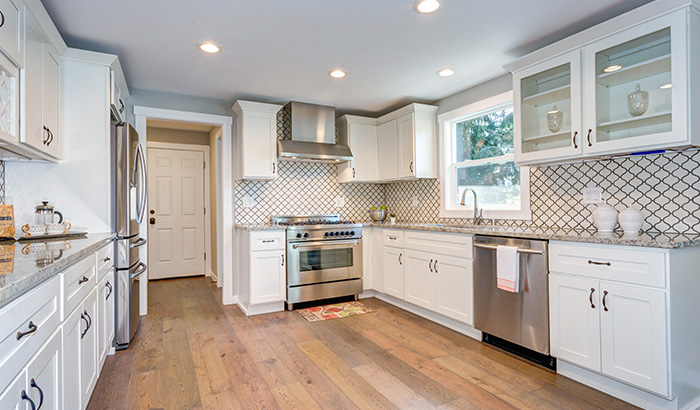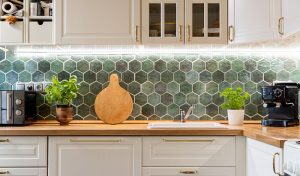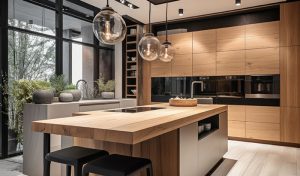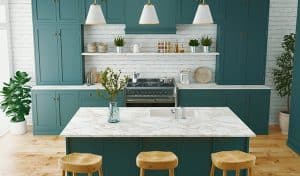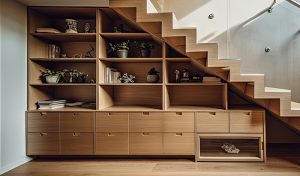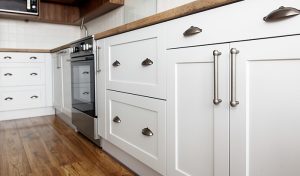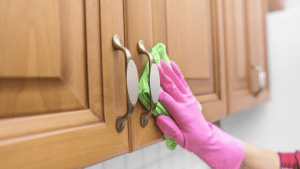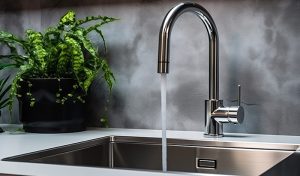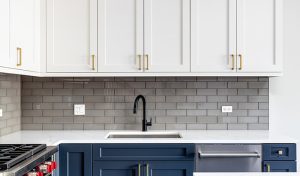Selecting a kitchen backsplash involves more than aesthetics; it also encompasses practical considerations. This comprehensive guide is designed to assist you in making informed decisions, guiding you through many choices, including materials, styles, costs, and maintenance.
Following this guide, you can identify the ideal backsplash that complements your kitchen’s visual appeal and suits your functional needs and lifestyle.
So, whether you’re on a budget or looking to splurge, going for classic or modern aesthetics, we’ve got you covered on what to consider.
Let’s examine the various factors that go into selecting a kitchen backsplash so you can make an informed choice that perfectly aligns with what you’re looking for.
What Material Should I Use?
Option 1: Ceramic Tiles
- Durability Ceramic tiles are generally very durable, crack-resistant, and easy to clean. If you plan to cook often and anticipate splatters, ceramic tiles will stand up to the cleaning agents needed to keep them spotless.
- Design Options: Ceramic tiles come in square, rectangular, and even hexagonal shapes. The array of colors and finishes allows for both traditional and modern aesthetics. There is an option for almost every design vision you have.
- Cost Factor: Ceramic tiles are among the most cost-effective options, making them great for budget-conscious individuals. However, prices can range based on the quality and design of the tile. Imported Italian tiles, for example, can be significantly pricier than domestic ones.
- Installation: These tiles are relatively easy to install, which means you could even undertake a DIY project if you’re handy. However, professional installation will ensure better longevity and finish.
Option 2: Glass Tiles
- Reflectiveness: Glass tiles offer a luminous quality, reflecting light and adding depth and brightness to your kitchen space. This works exceptionally well in kitchens that have limited natural light.
- Color Consistency: Unlike natural stone, glass tiles offer a consistent color all the way through, which can result in a cleaner, more streamlined look.
- Cost: Generally, glass tiles are more expensive than ceramic options. Installation costs might also be higher due to the fragile nature of the material, requiring a specialized skill set for proper setting and grouting.
- Maintenance: Glass tiles are easy to clean but can show water spots, so they might need to be wiped down more frequently to maintain sparkle.
Option 3: Natural Stone
- Unique Patterns: One of the most compelling reasons to choose natural stone is the uniqueness of each piece. Whether it’s the complex veining of marble or the earthy tones of slate, each tile is a one-of-a-kind creation.
- Maintenance: Natural stones like marble require regular sealing to maintain appearance and prevent staining. Acidic substances like tomato sauce or lemon juice can etch the surface, so it’s essential to clean up any spills immediately.
- Cost: Natural stone is generally at the higher end of the price spectrum. While this is partly because of the material, it’s also because of the specialized installation process.
- Sustainability: If you are environmentally conscious, research the quarrying practices related to your chosen stone. Sustainable sourcing can be a significant factor in your decision-making process.
Option 4: Stainless Steel
- Industrial Aesthetic: If your kitchen has a modern or industrial design, stainless steel can add to that sleek, streamlined effect.
- Heat and Water Resistance: It’s highly durable and can withstand the heat from your stove and the moisture from your sink, making it an excellent functional choice.
- Scratch Factor: Stainless steel is prone to scratching, so using abrasive cleaners is not recommended. Over time, it may show signs of wear and tear more readily than stone or ceramic options.
- Cost: This material might be costly for the initial outlay and the specialized installation, which often involves attaching the steel to a substrate for better durability.
Option 5: Wood
- Warmth and Texture: Wood brings a tactile warmth that no other material can offer. It’s an excellent option if you’re going for a rustic or farmhouse aesthetic.
- Durability Concerns: Wood is not naturally resistant to water or heat, so it needs to be sealed and maintained more rigorously than other backsplash options.
- Cost: Depending on the type of wood and the complexity of the design, wooden backsplashes can be expensive. Reclaimed wood is often a cost-effective and environmentally friendly option.
- Maintenance: Wood surfaces must be resealed periodically, and care must be taken not to use overly abrasive cleaners that could remove the finish.
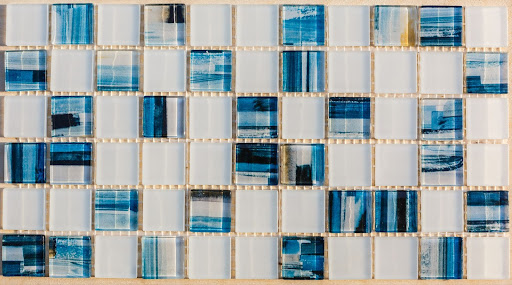
What Color Should I Pick?
Matching With Countertops
- Harmonious Look: Creating a harmonious look by matching your backsplash to your countertop results in a well-coordinated design. However, bringing samples of your countertop material is essential when choosing your backsplash to get the most accurate color match.
- Balance of Attention: A simpler, more understated backsplash might be more appropriate if your countertop has a strong pattern or texture. Conversely, a plain countertop can be a backdrop for a more attention-grabbing backsplash.
- Focal Point: Using an accent color creates a focal point in your kitchen, drawing attention to the backsplash area. However, make sure that the accent color ties into the overall color scheme of your kitchen to maintain a cohesive look.
- Changeability: Remember, if you choose a bold accent color, you commit to that color palette unless you plan to change the backsplash when you redecorate.
Neutral Tones
- Flexibility: Neutral tones offer great flexibility for future redecoration. They are a blank canvas, allowing you to change other elements like wall color, appliances, or accessories while keeping the backsplash consistent.
- Longevity: Because they’re not tied to specific trends, neutral colors might provide a more timeless look, contributing to the longevity of your design choices.
Dark Colors
- Depth and Dimension: Dark colors can give the illusion of depth and be particularly effective if you have a larger kitchen space that feels too open.
- Lighting: If you choose a darker color, you’ll need to consider your lighting carefully. Under-cabinet lighting or spotlights can illuminate a dark backsplash and prevent it from making the kitchen feel smaller or dimmer.
What About Pattern and Texture?
Option 1: Subway Tiles
- Traditional vs. Modern: The classic subway tile can be adapted to suit traditional and modern aesthetics, depending on your chosen color and finish. For instance, a glossy white subway tile can look quite contemporary, while a matte finish in a softer color can appear more traditional.
- Layout Options: Arranging your subway tiles can significantly impact the final look. For example, a herringbone pattern adds dynamism and visual interest, while a simple stacked arrangement creates a cleaner, more straightforward aesthetic.
Option 2: Mosaic Tiles
- Artistic Expression: Mosaic tiles allow for intricate designs and a high level of customization. From abstract patterns to more literal representations, mosaics offer endless artistic possibilities.
- Installation Complexity: Because of their complexity, mosaic tiles are usually more challenging and time-consuming. This can result in higher labor costs, so factoring this into your budget is crucial.
Option 3: Geometric Shapes
- Modern Flair: Geometrically shaped tiles like hexagons, diamonds, or Moroccan fish scales add a modern flair to your kitchen.
- Installation Challenges: The irregular shapes often mean more complicated cuts and a more challenging installation process, possibly leading to higher labor costs and more material waste.
Option 4: Textured Tiles
- Sensory Experience: Adding texture introduces a visual and tactile element to your kitchen. This is particularly effective if the rest of your kitchen has a more monochromatic or minimalist design.
- Cleaning Considerations: Heavily textured tiles may be more challenging to clean, with more crevices for dirt and grime to accumulate. This is an essential factor if you cook frequently.
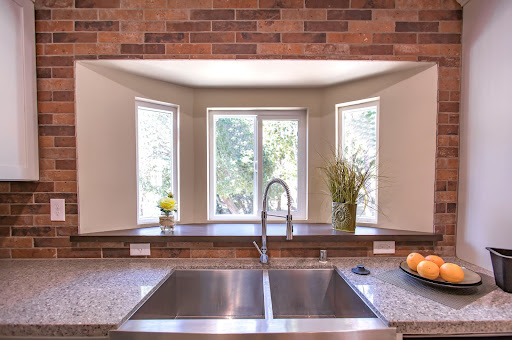
What About Your Budget?
Cost of Material
- Initial Investment: The raw cost of the material is often the most visible aspect of your budget. It’s easy to get swept away by premium options, but it’s important to ground your choices in financial reality. Knowing the price per square foot will help you understand how your choice scales up to cover the necessary area.
- Quality Grades: Understand that materials come in different grades or quality tiers. For example, porcelain tiles can be significantly more expensive than basic ceramic tiles due to their durability and finish quality.
- Installation Costs: Some materials are straightforward to install, reducing labor costs. On the other hand, others, like mosaics or natural stone, may require specialized skills. Be sure to ask for estimates that include labor when budgeting.
Additional Materials
Pay attention to the cost of additional materials like grout, sealant, or backer boards that may be required for installation. These can add to the overall cost.
Longevity vs. Cost
- Short-Term vs. Long-Term: Sometimes, spending more upfront can save you money in the long run. More durable premium materials will require less frequent replacements and could be a more cost-effective choice over the years.
- Resale Value: Consider the potential impact on your home’s resale value. A well-chosen backsplash could be a selling point that recoups its cost when you decide to move.
What About Functionality?
Durability
- Daily Wear and Tear: Think about your cooking habits. If your stove sees heavy use, your backsplash material should withstand heat, steam, and splatters. Similarly, consider water resistance, especially if the backsplash extends behind the sink.
- Child and Pet Considerations: If you have young children or pets, you’ll want a material that is resilient enough to withstand accidental bumps, spills, and splashes and is easy to clean.
Maintenance
- Cleaning Requirements: Some materials require more meticulous cleaning routines. While stainless steel and glass can be wiped down with a damp cloth, natural stones may require special cleaning agents.
- Regular Upkeep: Some materials, like natural stone, need to be sealed regularly to maintain their appearance and durability. Account for the time and cost of this upkeep when making your selection.
Height and Coverage
- Wall Coverage: Determine how much of the wall you want your backsplash to cover. Some opt for a shorter backsplash to save on costs or to feature other elements like wall art. Others prefer a backsplash that extends from the countertop to the upper cabinets or even up to the ceiling for a more dramatic look.
- Area Measurements: Accurate measurements are crucial for cost calculations and ensuring that patterns align correctly, particularly with larger tiles or complex mosaics.
What About Lighting?
Natural Light
- Window Considerations: If your kitchen has abundant natural light, you might opt for a matte finish to reduce glare or a darker color to add some contrast.
- Daytime Variations: Keep in mind how natural light changes throughout the day. A color or material that looks fantastic in morning light might look drastically different in the evening.
Artificial Lighting
- Lighting Types: The kind of artificial lighting you have significantly impacts how your backsplash looks. LED lights are different from incandescent or halogen lights, each affecting the color and texture of your backsplash differently.
- Adjustable Lighting: Consider installing adjustable lighting to control the ambiance. Dimmer switches or color-changing LED strips under the cabinets can help you adapt the space for different moods or tasks.
By considering each of these elements, you can select a kitchen backsplash that is aesthetically pleasing, functional, durable, and within budget. The key is to take your time, collect samples, research, and consult with design professionals if needed. A well-chosen backsplash completes your kitchen, making it a more inviting and efficient space to cook, dine, and socialize.
Customize Your Kitchen Backsplash With Mountain States Kitchen and Bath
Are you prepared to personalize your kitchen backsplash? Mountain States Kitchen and Bath provides a guaranteed way to achieve your kitchen’s perfect look and ambiance.
Our expertise lies in renovating kitchens and bathrooms throughout the Wasatch Front, spanning from Spanish Fork to Salt Lake City, Utah, and all points in between. Contact Mountain States today to explore our offerings, or visit our Lehi, Utah, showroom to view our stunning options and designs in person.
We’re here to address any inquiries or arrange an in-home consultation at your convenience. Let us assist you in crafting the home of your dreams. We’re eager to collaborate with you!

